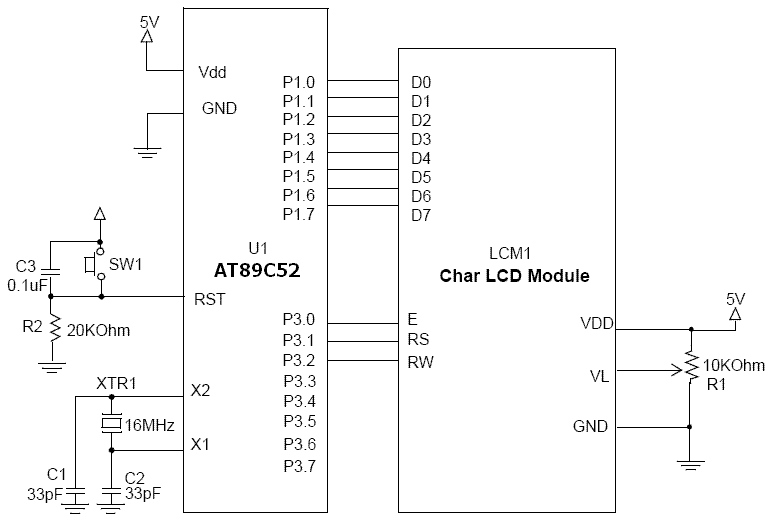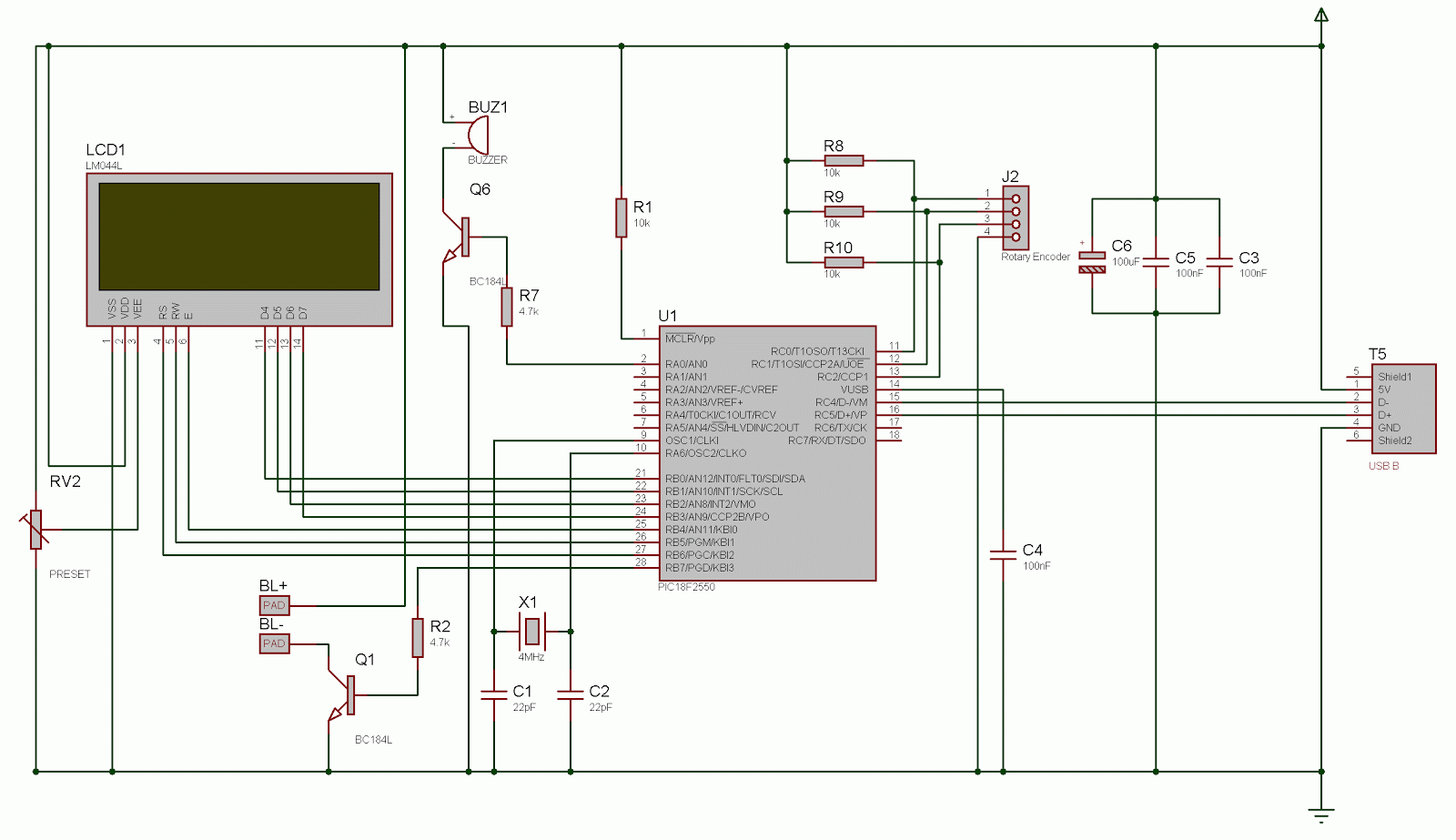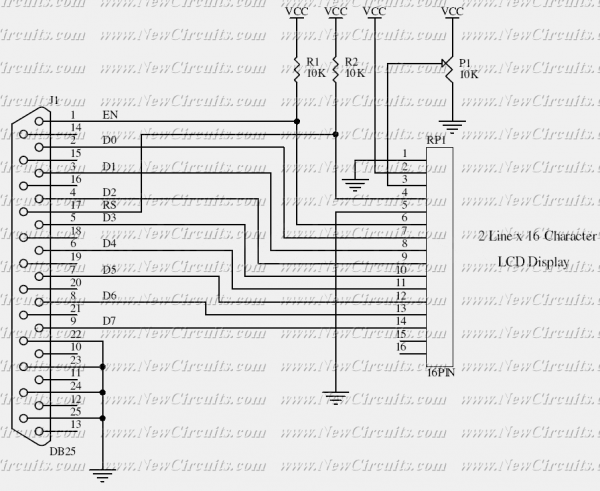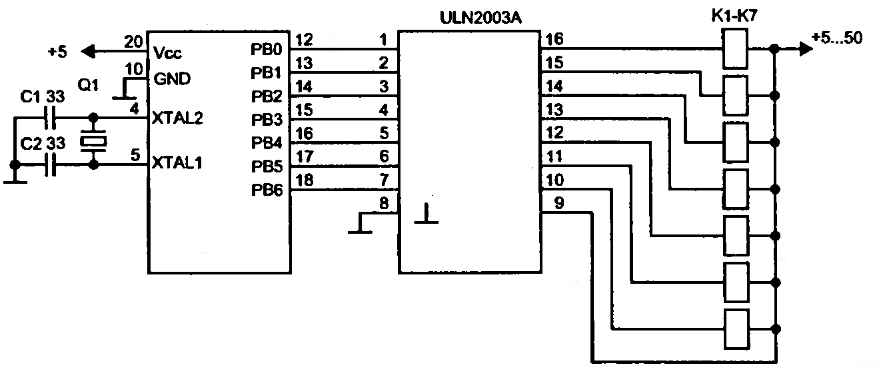
AVR to LCD
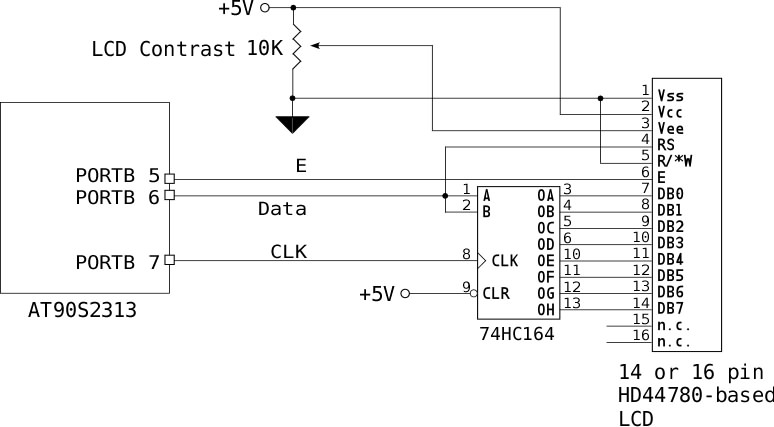
If no characters are displayed on the LCD and the hardware and software have been verified as functional, adjust the LCD Contrast potentiometer until the characters become visible. To send an 8-bit character or command to the LCD via the 74HC164 shift register, the code shifts the byte out one bit at a time through PORTB bit 6 (LCDDat), while toggling PORTB bit 7 (LCDClk) for each bit. The data is latched on the rising edge of the clock, so the data bit should be set before the clock signal is toggled. After the byte has been loaded into the shift register and is available on the LCD Data bus pins, the code selects the appropriate LCD register (data or command) by setting the LCDDat pin either low or high. The LCDClk pin remains static, causing the 74HC164 to ignore the data until the RS pin is set. The code then toggles the LCD E clock (LCDE, PORTB pin 5), allowing the LCD to read the data on its data bus. The LCD will not process any data until the E clock is pulsed high, similar to the Enable clock found in many older 6800 and 6502 peripheral chips. Although the AT90S2313 does not have a fully functional SPI bus, other AVR components do. The SPI port on these devices can be utilized for communication with this circuit, provided the code is adjusted accordingly. The HD44780 is a relatively slow device, so it is advisable to introduce a delay between bytes sent, despite the serialization routine. The code is designed for a 10MHz AT90S2313 microcontroller; timing delays should be modified for different CPU clock speeds. The timing values for the 8-bit timer used in the delay routine were calculated using Andyrate, which is no longer available; however, AVRCalc, developed by Kevin Rosenberg, can be used to generate the necessary timer values.
To implement the described functionality, a schematic can be constructed using the 74HC164 shift register connected to the AT90S2313 microcontroller and the HD44780 LCD. The microcontroller's PORTB will serve multiple functions: PORTB bit 6 will transmit the data (LCDDat) to the shift register, while bit 7 (LCDClk) will provide the clock signal for shifting the bits. The LCDE pin (PORTB pin 5) will control the enable signal for the LCD, ensuring that the data is read at the correct time.
The LCD's contrast is adjusted via a potentiometer, connected to the appropriate pin on the LCD to ensure visibility of the characters. The communication between the microcontroller and the LCD is managed through a bit-banging method, where the microcontroller manually controls the timing of the signals, which is particularly important given the HD44780's slower response time.
To ensure proper operation, the timing of the clock signals and the delays between data transmissions should be carefully calculated based on the specific clock frequency of the AT90S2313. The delays can be implemented using timer interrupts or busy-wait loops, depending on the desired efficiency and complexity of the code.
In summary, the design integrates a shift register to facilitate communication with the LCD, ensuring that the data is properly serialized and latched. The careful management of control signals and timing will lead to reliable performance of the LCD display in conjunction with the microcontroller.If you can`t see any characters displayed on the LCD (and you`ve checked that the hardware and software are working) turn the LCD Contrast pot until you can see the characters. To load an 8 bit character or LCD command into the 74HC164 shift register, the code shifts the byte out bit by bit through PORTB bit 6, (LCDDat) clocking the 74HC164 clockby toggling PORTB
bit 7 (LCDClk) for each bit. The data is latched on the rising edge of the clock, so the data bit on the port should be set first. Once the byte has been loaded into the shift register (and is now appearing on the LCD Data bus pins) the code selects the LCD register (either data or command) by setting the LCDDat pin low or high.
Since the LCDClk pin is not being toggled, the 74HC164 ignores this data. Once RS is set, the code toggles the LCD E clock (LCDE, PORTB pin 5) and the LCD reads the data on its data bus. The LCD will ignore all data on its data bus until its E clock is pulsed high, similar tothe Enable clock on many old 6800 and 6502 peripheral chips.
The AT90S2313 doesn`t have a fully functional SPI bus, but some other AVR parts do. You can use the SPI port on these devices to communicate with this circuit - with the appropriate changes in code. The HD44780 is a particularly slow device, so even though command and character bytes have to go through a serialization routine first, it`s still a good thing to add a delay between bytes sent.
The code assumes a 10MHZ AT90S2313 part; change the timing delays accordingly for different CPU clocks. I used Andyrate (which is no longer available) to calculate the timing values for the 8 bit timer used in the Delay routine.
Kevin Rosenberg has AVRCalc, which can be used instead to generate the timer values. 🔗 External reference
To implement the described functionality, a schematic can be constructed using the 74HC164 shift register connected to the AT90S2313 microcontroller and the HD44780 LCD. The microcontroller's PORTB will serve multiple functions: PORTB bit 6 will transmit the data (LCDDat) to the shift register, while bit 7 (LCDClk) will provide the clock signal for shifting the bits. The LCDE pin (PORTB pin 5) will control the enable signal for the LCD, ensuring that the data is read at the correct time.
The LCD's contrast is adjusted via a potentiometer, connected to the appropriate pin on the LCD to ensure visibility of the characters. The communication between the microcontroller and the LCD is managed through a bit-banging method, where the microcontroller manually controls the timing of the signals, which is particularly important given the HD44780's slower response time.
To ensure proper operation, the timing of the clock signals and the delays between data transmissions should be carefully calculated based on the specific clock frequency of the AT90S2313. The delays can be implemented using timer interrupts or busy-wait loops, depending on the desired efficiency and complexity of the code.
In summary, the design integrates a shift register to facilitate communication with the LCD, ensuring that the data is properly serialized and latched. The careful management of control signals and timing will lead to reliable performance of the LCD display in conjunction with the microcontroller.If you can`t see any characters displayed on the LCD (and you`ve checked that the hardware and software are working) turn the LCD Contrast pot until you can see the characters. To load an 8 bit character or LCD command into the 74HC164 shift register, the code shifts the byte out bit by bit through PORTB bit 6, (LCDDat) clocking the 74HC164 clockby toggling PORTB
bit 7 (LCDClk) for each bit. The data is latched on the rising edge of the clock, so the data bit on the port should be set first. Once the byte has been loaded into the shift register (and is now appearing on the LCD Data bus pins) the code selects the LCD register (either data or command) by setting the LCDDat pin low or high.
Since the LCDClk pin is not being toggled, the 74HC164 ignores this data. Once RS is set, the code toggles the LCD E clock (LCDE, PORTB pin 5) and the LCD reads the data on its data bus. The LCD will ignore all data on its data bus until its E clock is pulsed high, similar tothe Enable clock on many old 6800 and 6502 peripheral chips.
The AT90S2313 doesn`t have a fully functional SPI bus, but some other AVR parts do. You can use the SPI port on these devices to communicate with this circuit - with the appropriate changes in code. The HD44780 is a particularly slow device, so even though command and character bytes have to go through a serialization routine first, it`s still a good thing to add a delay between bytes sent.
The code assumes a 10MHZ AT90S2313 part; change the timing delays accordingly for different CPU clocks. I used Andyrate (which is no longer available) to calculate the timing values for the 8 bit timer used in the Delay routine.
Kevin Rosenberg has AVRCalc, which can be used instead to generate the timer values. 🔗 External reference
Warning: include(partials/cookie-banner.php): Failed to open stream: Permission denied in /var/www/html/nextgr/view-circuit.php on line 713
Warning: include(): Failed opening 'partials/cookie-banner.php' for inclusion (include_path='.:/usr/share/php') in /var/www/html/nextgr/view-circuit.php on line 713
